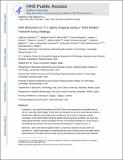SAR reduction in 7T C-spine imaging using a “dark modes” transmit array strategy
Author(s)
Guerin, Bastien; Keil, Boris; Mareyam, Azma; Kosior, Robert K.; Martin, Adrian; Torrado-Carvajal, Angel; Malpica, Norberto; Hernandez-Tamames, Juan A.; Schiavi, Emanuele; Eryaman, Yigitcan; Adalsteinsson, Elfar; Lopez Herraiz, Joaquin; Wald, Lawrence; ... Show more Show less
DownloadSAR reduction.pdf (1.510Mb)
OPEN_ACCESS_POLICY
Open Access Policy
Creative Commons Attribution-Noncommercial-Share Alike
Terms of use
Metadata
Show full item recordAbstract
Purpose: Local specific absorption rate (SAR) limits many applications of parallel transmit (pTx) in ultra high-field imaging. In this Note, we introduce the use of an array element, which is intentionally inefficient at generating spin excitation (a “dark mode”) to attempt a partial cancellation of the electric field from those elements that do generate excitation. We show that adding dipole elements oriented orthogonal to their conventional orientation to a linear array of conventional loop elements can lower the local SAR hotspot in a C-spine array at 7 T.
Methods: We model electromagnetic fields in a head/torso model to calculate SAR and excitation B1+ patterns generated by conventional loop arrays and loop arrays with added electric dipole elements. We utilize the dark modes that are generated by the intentional and inefficient orientation of dipole elements in order to reduce peak 10g local SAR while maintaining excitation fidelity.
Results: For B[subscript 1][superscript +] shimming in the spine, the addition of dipole elements did not significantly alter the B[subscript 1][superscript +] spatial pattern but reduced local SAR by 36%.
Conclusion: The dipole elements provide a sufficiently complimentary B1+ and electric field pattern to the loop array that can be exploited by the radiofrequency shimming algorithm to reduce local SAR.
Date issued
2014-04Department
Institute for Medical Engineering and Science; Harvard-MIT Program in Health Sciences and Technology; Massachusetts Institute of Technology. Department of Electrical Engineering and Computer Science; Massachusetts Institute of Technology. Research Laboratory of ElectronicsJournal
Magnetic Resonance in Medicine
Publisher
Wiley Blackwell
Citation
Eryaman, Yigitcan et al. “SAR Reduction in 7T C-Spine Imaging Using a ‘dark Modes’ Transmit Array Strategy: SAR Reduction Using a ‘Dark Modes’ Strategy.” Magnetic Resonance in Medicine 73.4 (2015): 1533–1539.
Version: Author's final manuscript
ISSN
0740-3194
1522-2594